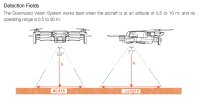Not the front/side/top/bottom obstacle avoidance sensors. And not the optical sensor used for horizontal position hold. I'm talking about the infrared sensors of the Downward Vision Positioning System (VPS).
The system is called different names in different models, and on older models used ultrasonic sensors rather than infrared. They function similarly in any case, sending a pulsed signal which bounces off the ground, with the reflected signal then received by the drone (like a radar altimeter). The time it takes (Time of Flight) between the signal being sent and returned is used to very accurately calculate the height of the drone above whatever lies below. That part I understand.
I also understand it has limited range. The user manual for my Mini says its operating range is 0.5-30m, but "works best" between 0.5-10m, and obviously the strength of the reflection is affected by different surfaces. When within range of a good reflection, the height is recorded in the flight log as VPS-height. The app for my old Phantom 3 Pro actively displayed the VPS height on screen, which was sometimes very useful, whereas the DJI Fly app for my Mini only ever shows the barometric altimeter referenced to zero from the takeoff location.
I previously posted a playlist of five different videos demonstrating how my Mini never reacts in any noticeable way to changes in the measured VPS height during flight or hover, UNLESS during autolanding or whenever a VPS height of less than 0.5m (~2ft) is detected. Other than in those exceptions, it is always the IMU and barometric altimeter which determine how the drone maintains constant height.
So what does the drone ACTUALLY DO with that VPS height information up to ~30m height? Yes, it is accurately measuring height. But for what purpose?
First, go read this very interesting thread, and give it some thought:
mavicpilots.com/threads/low-gps-signal-bad-vision-system-data-leading-to-fly-away-and-crash.148451/
Also see more details in the corresponding thread over on the DJI forum:
forum.dji.com/forum.php?mod=viewthread&tid=318816&pbc=mF6h4ZTt
That case involved a DJI Mini 3 Pro flown low over a fast moving river in the bottom of a steep canyon, resulting in loss of the drone for what seemed like obvious reasons. But the conclusions in that thread have caused me to reconsider pretty much everything I've ever believed and previously wrote about the functioning of the VPS system.
I've had some new thoughts about that now, which I will explain in my following five posts here. It involves "speed limits" and how those are implemented.
Hold your fire, keep your powder dry, read those other two message threads, and then read my following five posts...
The system is called different names in different models, and on older models used ultrasonic sensors rather than infrared. They function similarly in any case, sending a pulsed signal which bounces off the ground, with the reflected signal then received by the drone (like a radar altimeter). The time it takes (Time of Flight) between the signal being sent and returned is used to very accurately calculate the height of the drone above whatever lies below. That part I understand.
I also understand it has limited range. The user manual for my Mini says its operating range is 0.5-30m, but "works best" between 0.5-10m, and obviously the strength of the reflection is affected by different surfaces. When within range of a good reflection, the height is recorded in the flight log as VPS-height. The app for my old Phantom 3 Pro actively displayed the VPS height on screen, which was sometimes very useful, whereas the DJI Fly app for my Mini only ever shows the barometric altimeter referenced to zero from the takeoff location.
I previously posted a playlist of five different videos demonstrating how my Mini never reacts in any noticeable way to changes in the measured VPS height during flight or hover, UNLESS during autolanding or whenever a VPS height of less than 0.5m (~2ft) is detected. Other than in those exceptions, it is always the IMU and barometric altimeter which determine how the drone maintains constant height.
So what does the drone ACTUALLY DO with that VPS height information up to ~30m height? Yes, it is accurately measuring height. But for what purpose?
First, go read this very interesting thread, and give it some thought:
mavicpilots.com/threads/low-gps-signal-bad-vision-system-data-leading-to-fly-away-and-crash.148451/
Also see more details in the corresponding thread over on the DJI forum:
forum.dji.com/forum.php?mod=viewthread&tid=318816&pbc=mF6h4ZTt
That case involved a DJI Mini 3 Pro flown low over a fast moving river in the bottom of a steep canyon, resulting in loss of the drone for what seemed like obvious reasons. But the conclusions in that thread have caused me to reconsider pretty much everything I've ever believed and previously wrote about the functioning of the VPS system.
I've had some new thoughts about that now, which I will explain in my following five posts here. It involves "speed limits" and how those are implemented.
Hold your fire, keep your powder dry, read those other two message threads, and then read my following five posts...











